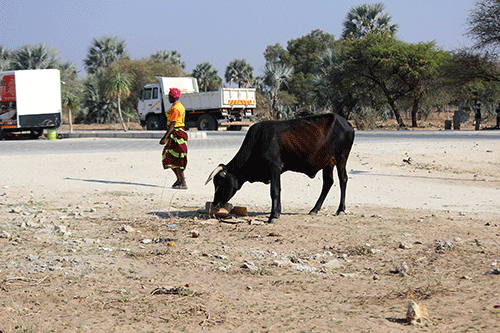Aletta Shikololo
Maihapa Ndjavera
The Office of the Prime Minister has announced that between July and September this year, approximately 579 000 people in Namibia are estimated to be facing high levels of acute food insecurity and requiring urgent humanitarian assistance.
While launching the 2023/2024 Livelihood Vulnerability Assessment and Analysis (VAA) on Wednesday, the executive director in the OPM, I-Ben Nashandi, said most households do not have any food stocks during the current period. Most have also indicated that they will have stocks lasting less than one month, and those who had stocks lasting between one to three months have already depleted their food stock.
As a result, “households have already experienced difficulties in purchasing food due to a lack of income and high unemployment rates.”
It is projected that during the period October 2023 to March 2024, the number of people expected to experience food insecurity would further rise to 695 000 people, amounting to roughly 26% of the population.
The OPM conducts annual VAA to inform policy and further aid the understanding of threats of natural and socio-economic disasters to food and nutrition security in the country.
Namibia experienced below-normal and sporadic rainfalls that subjected communities to prospects of lower crop yields, impacts on livestock, and ultimately reduced household food stocks, compromising food security at household levels.
The agriculture ministry states in their crop prospects, food security and drought situation report for July 2023 that the 2022/23 estimates show that the nation has harvested 153 000 MT, which is 9% less than the harvest of 168 200 MT from the previous season (2021/22), but 23% above the 10 years’ average production of 124 200 MT.
“With the anticipated El Niño, which is likely to affect us during the 2023/24 agricultural season, the situation in the country will be negatively affected due to more dry and limited rainfall, which could put food security in the country at risk,” they added.
At regional level, the food-insecure population ranges from 15% both in the Erongo and Khomas regions, and 30% and 40% in the Kavango West and Kavango East regions, respectively.
Earlier this week, New Era reported that hunger and poverty have pushed a destitute Ovatjimba family in the Kunene region into scavenging for goat skins to feed themselves.
This family adds up to the massive statistics of people living with hunger in the country.
BIG need
Basic Income Grant (BIG) activist Casper Bowora said it is about time the government hastened the implementation process for a monthly cash grant.
“At least assist those in need, and give them a basic income grant that will allow everyone to be independent. With the increase in food prices and high unemployment, the basic income grant will allow people to cope well during these tough economic situations,” he reasoned.
Earlier this year, Cabinet approved a proposition to convert the Food Bank and the special feeding for marginalised communities’ grant into a monthly cash transfer of N$600 per household.
Senior economist Omu Kakujaha-Matundu said the government should declare the situation an emergency.
“Food insecurity points to children being mal- and under-nourished. Malnutrition leads to stunted growth. Stunted growth affects school performance and compromises the human resources of the country. In turn, it affects economic growth and development,” he stated.
Kakujaha-Matundu, therefore, urged the government to step up on the school- feeding scheme to include day-learners.
“At least get one nutritional meal for day-learners and three for hostel dwellers,” he suggested.
Another economist, Mally Likukela, said the statistics reveal a deep-rooted policy deficiency.
He said the increase in the numbers of food insecure does not reflect the extent of public funding going to the agriculture sector.
Secondly, the poor outcome in the sector reveals a poor implementation of policies and intervention in the sector, he added.
“Thirdly, this outturn shows that Namibia is far from achieving goal two – zero hunger – despite government pronouncements of a commitment to achieving the SDGs,” he stressed.
Likukela expressed concerns about the poor nutritional state of especially the most vulnerable – children and women.
“Given the massive amount of public funds going towards agriculture, this can only point to serious inefficiency in resource allocation,” he said.
He thus urged government to realign the public finance framework towards agriculture, and ensure accountability for resources mismanagement and to demand value for money.
“Reinvigorate the green schemes in the Zambezi and Kavango regions. Strengthen the social safety nets to ensure that the most food-insecure are covered, and promote self-sustainable food production in the rural areas,” the economist added.
No casualty
Nashandi reiterated government’s commitment of ensuring that no Namibian citizen will die as a result of hunger.
The OPM is expected to roll out the drought relief programme and food assistance to all affected subsistence farmers in rural areas in all the 14 regions, effective 1 October 2023 to June 2024, while the livestock support programme will be implemented from 01 October 2023 to 31 March 2024.
This programme is expected to cost government N$892, 4 million.
The report further recommended the monitoring of prices for staple commodities, informal cross-border food trade, the impact of Covid-19 on food security, inflation and its impact on the Namibia dollar, seasonal rainfall performance, and the drought situation in Kunene, Omusati, Erongo and other potential regions, amongst other recommendations.


